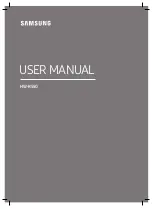
6
Connecting your speakers to the amplifier/receiver
While speaker set-up can be daunting, wire set-up is relatively easy. Before connecting
your speaker cables to the terminals and appropriate components, prepare and inter-
connect the amplifier, preamp, and additional music systems as per each component’s
instructions.
For correct and lifelike sound reproduction, both speakers in a stereo system must
be wired in the same polarity. The speaker’s input terminals are color coded to make
connecting the cables straight-forward.
• The wire connected to the
red-ringed
input terminal of each speaker should connect to the
respective
positive (+)
output terminals of the amplifier/receiver.
• The wire connected to the
black-ringed
input terminals should be connected to the
respective
negative (–)
output terminals of the amplifier/receiver.
It is important to note that the quality of the speaker cables and other interconnections
significantly affects the performance of your entertainment system.
Speaker cables
The shipping boxes do not contain the cables (wiring) needed to connect the speakers
to your amplifier/receiver. Cables must be purchased separately. It’s important to know
that old or inexpensive speaker cables can diminish the sound quality of your THIEL
speakers. It pays to use high-quality, low-gauge cables to connect your speakers to the
amplifier/receiver. Low-gauge cables ensure minimal loss of power (thanks to reduced
impedance) and proper control by the amplifier. Consider these factors when choosing
cables for your sound system: gauge and length
.
Gauge. All speaker cables have an American Wire Gauge (AWG) number (ranging
from 0000 to 40) that indicates the thickness of the wire’s copper bundle (the all-
important electric conductor). A lower gauge means a thicker wire. And the thicker the
wire, the better it conducts the signal from your amplifier to your speakers. Speaker
cables used with stereo and home entertainment systems typically range from 10
gauge to 18 gauge.
Length. Cable length also affects sound quality. For example, bookshelf speakers are
often placed relatively close to the receiver or amplifier (within 6.5 feet); in that case,
you can use shorter, higher gauge (18 AWG), less expensive cables. However, if you
need or want to run cables longer than that, refer to
Figure 5
as a guide to the best
gauge for your home system.
We recommend using cables of nearly the same length (plus or minus 1 foot) for each
speaker. By using similar lengths of cable to connect your speakers to the amplifier/re-
ceiver, you’ll ensure that the speakers receive similar power and produce a similar sound
at a given volume.
Bi-amping
If you’re using a high-quality amplifier with high output capacity for your two-channel/
stereo system, there is probably no need to bi-amp. However, the limitations of your
current amplifier may persuade you to bi-amp your stereo system. If, for example, your
amplifier has a small output capability (in terms of watts) or you routinely play your
amplifier at high volume (it’s “overdriven”), distortion will occur. That happens because
with one, average-quality amplifier, most of the power goes to the woofer (handling
the low frequencies); so playing the stereo system at high volume distorts the higher
frequencies.
Bi-amping uses one amplifier for the low frequencies and a second amplifier for the mid
and high frequencies. Having two amplifiers means less distortion is audible in the mid
and high frequencies when your system is played at high volume or your amplifier is not
of high quality.
Figure 5
GAUGE
(AWG)
LENGTH IN METERS (M)
FROM THE SPEAKER TO
THE AMPLIFIER/RECEIVER
LENGTH IN FEET/INCHES
FROM THE SPEAKER TO
THE AMPLIFIER/RECEIVER
1 8
2 M
6 ’ 6 ”
17
2 . 3 M
7 ’ 5 ”
1 6
3 M
9 ’ 8 ”
1 5
3 . 4 M
11’
14
4 M
13 ’
13
5 M
1 6 ’ 4 ”
12
7 M
2 3 ’
11
7.7 M
> 2 5 ’
Содержание TC1
Страница 1: ...1 SOUND ABOVE ALL Owner sManual TM3 TT1 TC1 ...
Страница 12: ...1 2 NASHVILLE TN THIELaudio com ...






























